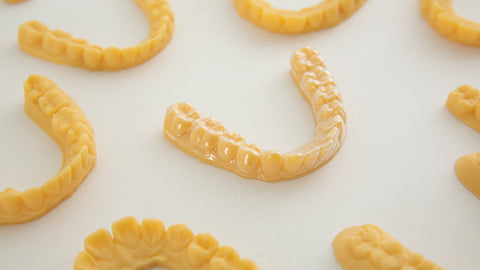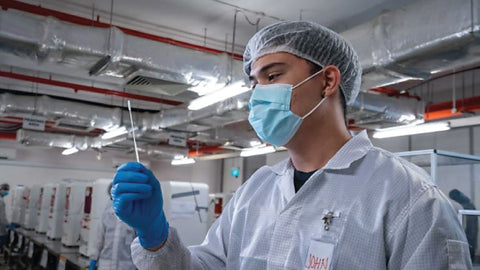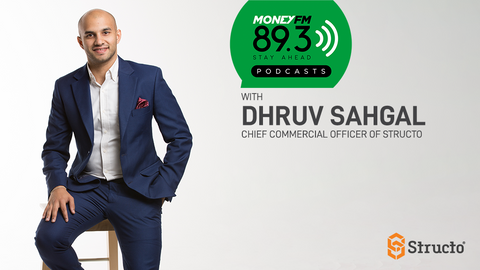Structo Buzz - 2017 Q3 Blog Highlights
October 14, 19 | 7 mins read
Since the launch of our blog, the clear aligner series has garnered a lot of attention from our readers. In this newsletter, we will give you a summary of the most popular topics that have been discussed.
1. The Birth of Clear Aligners
Clear aligners have taken the world by storm, and have become the go-to dental appliance in recent times thanks to its aesthetic appeal and ease of use among numerous other factors. Invisalign, the clear aligner brand by Align Technology soon became a household name thanks to its direct to consumer marketing that changed the general public's perception on orthodontic treatment.
For the benefit of those who are new to digital dentistry, clear aligners are made in 4 steps:

Step 1: An orthodontist takes a patient’s impression
Step 2: The scan is loaded into the design software where the technician cleans up the data, and sets up the treatment plan based on a list of guidelines
Step 3: The file is exported to a 3D printer, and each step of the treatment plan is printed out as physical models which will act as moulds for the next process.
Step 4: Using a thermoforming machine, thin, durable plastic sheets are thermoformed over the models, removed and cut to produce your final aligner.
2. 5 Things You Need to Start a Clear Aligner Business
In the second part of the Clear Aligner Series: 5 things you need to start a clear aligner business, we listed out the exact equipment you need to start a clear aligner business of your own. This serves to give you a big picture before you go ahead and make that investment towards your manufacturing lines
1. Digital Scanners - Intraoral And Desktop
There are several factors you will need to consider before purchasing a digital scanner. Firstly, it is crucial for you to purchase a system that fits your own workflow. Next, you will need to consider ease of use. And for the case of intraoral scanners, the size of the wand (area going into the patient’s mouth) is key. Accuracy used to be an issue when considering different digital scanner brands. But the industry has progressed to the point where many systems out there are accurate enough for chairside use. Finally, the most important factor to consider, price. Generally, intraoral scanner prices have gone down significantly over the years thanks to increased competition with new market entrants from every part of the world. You will be working within a range of US$15,000 - $50,000. Keep in mind that you will need to allocate an annual subscription cost to the overall purchase price for the software license on top of your one-off device price.
2. Treatment Planning Software
The next thing you need to consider is the computer-aided design (CAD) component of your digital workflow. This is the software tool you need to design how much tooth movement is allowed per clear aligner step. There are numerous providers out there in the market, but you do have to be aware that some digital scanners come with some sort of orthodontic software bundled together with their product. So, before you go ahead and purchase an extra piece of software, check with your scanner sales rep what is included in the bundle that you just purchased.
3. 3D Printers
After designing your treatment plan for your patient, you will now need to translate that digital file into a series of steps in the form of models using a 3D printer. There are numerous 3D printers out there in all shapes, sizes and prices. They range from desktop systems that will cost you a few thousand dollars all the way to industrial-sized systems that cost hundreds of thousands.
The most commonly-used 3D printing technology in dentistry is vat photopolymerization or resin-based 3D printing. In this category of 3D printing you have Stereolithography (SLA), Digital Light Processing (DLP), and Mask Stereolithography (MSLA). Each method has its inherent pros and cons. Read up more about how 3D Printing can fit into your workflow here.
4. Thermoforming Machines
Just like 3D printers, thermoforming machines come in all shapes, sizes and prices. When it comes to clear aligners manufacturing, what you really need to focus on are the quality of the thermoformed aligner and the temperature the thermoforming machine operates at. Choosing the right thermoforming machine will help you manufacture aligners that are the perfect negative of the model used. Always ask your sales rep for a sample before making your purchase decision!
5. A Brand
This does not cost you anything, but it may make or break your clear aligner business. The easiest way to put yourself on the front foot is to start with an optimized manufacturing process that gives you the cost advantage to compete in this billion-dollar industry.
3. Same Day Aligners - A Game Changer for the Orthodontic Industry [Guest Post]
To end off our clear aligner series, we partnered with Dr. Wilson - Founder & CEO of StraightSmile Solutions and the former Dental Director of SmileDirectClub to deliver an in-depth analysis of same day aligners. In this article, Dr. Wilson pointed out several ways to identify whether clear aligner is right for you and your practice and how to make it work.

1. Offering Invisalign® & In-house - Not Mutually Exclusive
To understand which selection can prove to be better for your business, you can start with offering both options, branded clear aligners and in-house solutions, and analyze the P&L and ROI. Evaluate both options according to the revenue they bring for your business and the usability in business operations. Not sure if this would work for you? There’s a solution for that. Check out this ROI calculator.
2. Case Selection
Start out by treating only mild to moderate, adult dentition, Class I malocclusion cases with the in-house aligner option. If you need guidance on case selection, StraightSmile Solutions® is the first online portal to provide a customized orthodontic coaching solution for every practice. Visit www.straightsmilesolutions.com to get started.
3. Help is readily available!
If you think setting up your own aligner brand sounds extremely complicated, it really is not. You have probably already purchased many of the necessary systems to streamline your office, like a 3D scanner and a thermoforming machine. The biggest hurdle to overcome for general dentists is often the treatment planning which you can partner with a company like eXceed® that will do the set up for you for a small fee.
As for 3D printers, Structo has an interesting blog post in this series that sheds light on the ideal 3D printing technology for aligner manufacturing. Or you can contact the Structo team and a representative will walk you through the entire process of setting up your manufacturing line.
4. New Revenue Stream - Dental Tourism
The dental tourism market is trending in many geographic areas. Another major benefit of opting for an in-house solution is that it will reduce the turnout time for the patients, who require minor tooth movement cases. While the turnaround time of Invisalign® is approximately two to three weeks, in-house solutions can be done only in a matter of hours, depending on the production capacity of your business. This creates an opportunity for the patients looking for convenience and the practitioners looking for increased profits.
5. Taking Control over Quality and Profits
With an in-house solution, you will be in charge of the manufacturing process; you will be able to control the final cost and the quality of the products. The process will require your utmost dedication, time, and effort, but all this will be worth the end result and the profits you will make. Moreover, having your own production line set up will enable you to start considering offering other appliances to your patients, which can include thermoforming mouth guards and splints.
If you want to learn more about adopting Structo's dental 3D printers for your clear aligner line, you can contact the team online. A representative will help you install the machine, train your team, and guide you through all the steps. Don’t hesitate to contact StraightSmile Solutions® with any questions.
[READ MORE]




